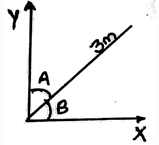Test: Frictional Forces On Flat Belts - Civil Engineering (CE) MCQ
15 Questions MCQ Test Engineering Mechanics - Test: Frictional Forces On Flat Belts
____________ is the phenomena that resist the movement of the two surfaces in contact, in some of the cases it could be the belts and the rolling cylinders.
The frictional force in the belts always acts ____________ to the surface of the application of the friction.
Vector shown in the figure below have a length of 3m and the angles shown A and B are 60 and 30 degrees each. Calculate the X-axis and Y-axis components.

Dry friction in the belt is also called ___________
For making the equilibrium equations for the belt the normal forces that are being acted over them are in which direction in the free body diagrams?
Which one is not the condition for the equilibrium in free body diagram for the belts as considered for calculation of the normal forces, consider all forces to be straight and linear?
We first make equilibrium equations of the belts by considering all the three dimensional forces acting on the section chosen and then the free body diagram is made and solved.
We show the net forces acting on the belts by the help of __________ forces.
There are main two types of forces which are being stated in the free body diagram of the belts, they are generally the resultant forces which are being acted over the body over which the belt is rolling. Which are they?
Determine the magnitude of the projection of the vector force F = 100N acting over a particular point on the belt, onto the v axis, from the figure given below.
The solving for the unknown forces in the belts requires vector math. So if a vector is multiplied by a scalar in the belt system of forces then_________
All the vector quantities in the solving of the unknown in the belt force system obey _____________
For solving of the unknown tension in the belts, which of the following equation is used?
Shown as in the figure below, A=60 degree and B=30 degree. Calculate the total length obtained by adding the x-axis component of both the vectors.
|
24 videos|59 docs|53 tests
|


















